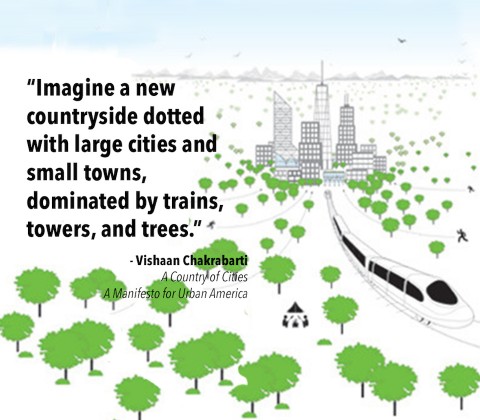Re-Imagining Cities
April 1, 2014 1 Comment
At IISC we often talk about three hugely important pieces of context for social change work these days:
- We are in the middle of a paradigm shift, from the Industrial Age into an age that doesn’t have a name yet
- By 2050, 70% of the world’s population will live in urban areas
- In 2042 the U.S. will become a majority people of color nation
In this context, as a nation and a globe we are choosing to face or ignore urgent questions about climate change, racism, wealth distribution, violence (the types we condone, penalize, and ignore), and the quality of life that we are willing or unwilling to insist upon for every human being on this planet. It’s quite overwhelming…
I recently read Vishaan Chakrabarti’s A Country of Cities: A Manifesto for an Urban America, a refreshingly energizing and accessible break down of the state of cities in the U.S. today and a series of seemingly simple (though not easy) solutions for sustainable, equitable cities where all people can thrive.
What does Chakrabarti see as the crux of the problem? Suburban sprawl. “The suburbs are not a mere reflection of the way people want to live, or even a reflection of true market forces, but a synthetic consequence of history. The suburbs are largely a creation of ‘big government,’ an explicit, policy-driven, subsidized scheme that has guided how we live, work, and play. Over the last century, this has created the most consumption-based economy the planet has known–that is, until the music stopped: the twenty-first century debuted in America with an epic collapse of the housing market (particularly the single-family housing market), the rapid acceleration of climate change, and the largest division between rich and poor in the postwar era.”
What does Chakrabarti see as the core of the solution? Hyperdense cities with an Infrastructure of Opportunity. “Imagine a new countryside dotted with large cities and small towns, dominated by trains, towers, and trees, with little but agriculture and nature in between. Imagine this transformation occurring in a matter of decades, just as it took only a few quick decades in the twentieth century to transform the beauty of America into anonymous sprawl…. Americans today are urbanizing, with the demand for high-rise multifamily rental housing increasing dramatically in the wake of the economic crisis. Young people, immigrants, and seniors alike want to live near mass transit, near shops and restaurants, and near each other. Economic opportunities, environmentalism, public health, diversity, and the inherent joy of cities are together creating a profound and lasting transformation of the lifestyle sought by everyday Americans.”
A few of the policy changes Chakrabarti recommends to this end in the U.S. are:
- In economically strong cities, mandate between 20 and 30 percent affordable housing in exchange for zoning that significantly increases allowable densities
- Gradually phase out the Mortgage Interest Deduction (At well over $100 billion per year, the MID is the largest housing subsidy that our government grants, and it is used disproportionately by wealthier Americans who buy more expensive homes. If we phased the MID out by 2024 and reduced the cap from $1 million per married couple at a rate of $100,000 per year until then, as the Congressional Budget Office recommended in 2011, we would recoup $517.6 billion without a shock to the housing market.)
- Finance the construction of tens of millions of affordable rental housing units in our cities (using half of the money recouped by the phase of the MID, referenced above) Note: Since 1960, the total amount of housing units in the U.S. has tripled, while the number of affordable units has remained essentially the same
1 Comment
Thanks Jen for the review! Important strategies worth exploring.